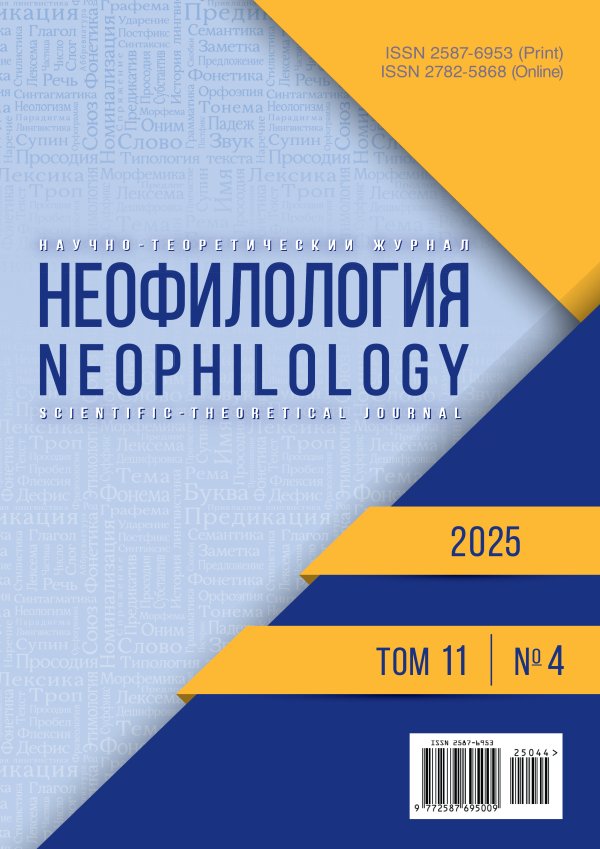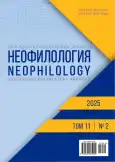Эсхатологический сюжет в творчестве И. Масодова
- Авторы: Куряев И.Р.1
-
Учреждения:
- ФГБОУ ВО «Национальный исследовательский Мордовский государственный университет им. Н.П. Огарёва»
- Выпуск: Том 11, № 2 (2025)
- Страницы: 335-345
- Раздел: ЛИТЕРАТУРНАЯ КАРТА В ЛИЦАХ, ФАКТАХ, СОБЫТИЯХ
- URL: https://journal-vniispk.ru/2587-6953/article/view/297437
- DOI: https://doi.org/10.20310/2587-6953-2025-11-2-335-345
- ID: 297437
Цитировать
Полный текст
Аннотация
ВВЕДЕНИЕ. Исследование посвящено изучению эсхатологического сюжета в творчестве И. Масодова. Целью исследования является определение специфики эсхатологической образности и тех механизмов, способствующих трансформации привычных сюжетов в рамках анализируемых произведений.
МАТЕРИАЛЫ И МЕТОДЫ. Материалом исследования явилась трилогия И. Масодова «Мрак твоих глаз» (2001), в которую входят романы «Мрак твоих глаз», «Тепло твоих рук», «Сладость губ твоих нежных». Исследование основывается на историко-культурном, мифопоэтическом, структурном, мотивном методах анализа.
РЕЗУЛЬТАТЫ ИССЛЕДОВАНИЯ. Установлено, что И. Масодов конструирует историю, которая, используя «советские» сюжеты и образы, показывает ситуацию апокалипсиса, «бесплодной земли» или же движение к этой ситуации. Главной героиней в каждом из романов становится девочка, которая, актуализируя жанровый аспект произведения, одновременно воплощает в себе образы невинной жертвы, ангела-истребителя и, в случае с романом «Мрак твоих глаз», рыцаря, находящегося в поисках Святого Грааля. Мир здесь существует по законам насилия, актуализирует мотивы смерти, все ключевые образы здесь переворачиваются, трансгрессируют, пространства предстают как некро-пространства. Поэтому действия мстящей за порочность мира героини связаны с мотивами смерти и уничтожения.
ЗАКЛЮЧЕНИЕ. Приём переворачивания привычного образа позволяет И. Масодову конструировать сюжеты, которые фокусируются на процессе распада, разрушения, изживания. Эсхатологический сюжет в трилогии писателя обретает подчёркнуто жанровое воплощение и в то же время фокусирует внимание на концепции греха и расплаты.
Ключевые слова
Об авторах
И. Р. Куряев
ФГБОУ ВО «Национальный исследовательский Мордовский государственный университет им. Н.П. Огарёва»
Автор, ответственный за переписку.
Email: kuryaev.ilgam@yandex.ru
ORCID iD: 0000-0002-4294-5817
кандидат филологических наук, доцент кафедры русской и зарубежной литературы
Россия, 430005, Российская Федерация, г. Саранск, ул. Большевистская, 68Список литературы
- Бессонов И.А. Русская народная эсхатология и эсхатология поздней античности: структурные и мотив-ные параллели // Традиционная культура. 2024. Т. 25. № 1. С. 123-136. https://doi.org/10.26158/TK.2024.25.1.008, https://elibrary.ru/eqsbwg
- Виноградова О.Н. Апокалиптические мотивы в поэме М.Ю. Лермонтова «Демон» // Филологические науки. Вопросы теории и практики. 2022. Т. 15. № 2. С. 236-240. https://doi.org/10.30853/phil20220027, https://elibrary.ru/pwdxze
- Волков Ю.К. Апокалиптические образы Данте и Соловьёва как контрапункты стиля эпохи перемен // Соловьёвские исследования. 2022. № 1 (73). С. 55-66. https://doi.org/10.17588/2076-9210.2022.1.055-066, https://elibrary.ru/eobfge
- Ким М. Эсхатологическая парадигма в рассказе В.Ф. Одоевского «Насмешка мертвеца» // Проблема ис-торической поэтики. 2024. № 22 (3). С. 75-91. https://doi.org/10.15393/j9.art.2024.14084, https://elibrary.ru/unjrpx
- Колягина Т.Ю. Апокалиптические мотивы в лирике Ф.И. Тютчева // Филологический вестник Сургутского государственного педагогического университета. 2022. № 1. С. 70-88. https://doi.org/10.26105/PBSSPU.2022.9.1.007, https://elibrary.ru/pbvncp
- Красавченко Т.Н. «Неоготика» модернизма: Дафна Дюморье и её апокалиптический «экологический» триллер «Птицы» // Литературоведческий журнал. 2024. № 3 (65). С. 138-155. https://doi.org/10.31249/litzhur/2024.65.10, https://elibrary.ru/ixjtpj
- Маматов Г.М. «Лишь музыка тихо сияла из чаши» – Образ Святого Грааля в лирике Б. Поплавского // Уральский филологический вестник. Серия: Русская литература XX–XXI веков: направления и течения. 2021. № 3. С. 50-61. https://doi.org/10.26170/23067462_2021_03_03, https://www.elibrary.ru/pzawca
- Солдаткина Я.В. Сюжет «конца света» в русской прозе XX–XXI вв. глазами героя-интеллигента: соци-альное, фантастические и аксиологическое // Новый филологический вестник. 2021. № 3 (58). С. 287-297. https://doi.org/10.54770/20729316_2021_3_287, https://elibrary.ru/erkpdn
- Суворова А.А. Эсхатологические и апокалиптические мотивы в современном российском искусстве // Артикульт. 2024. № 3 (55). С. 24-33. https://doi.org/10.28995/2227-6165-2024-3-24-33, https://elibrary.ru/scseqd
- Яковлев М.В. Апокалиптическое направление в русской поэзии XX века. Орехово-Зуево: Изд-во Гос. гум.-тех. ун-та, 2021. 300 с. https://elibrary.ru/xxocks
- Рудова Ю.В. Лингвокультурная специфика репрезентирования телесности (на примере русского и анг-лийского юмористического дискурса) // Вестник Северного (Арктического) федерального университета. Серия: Гуманитарные и социальные науки. 2022. № 1. С. 90-99. https://doi.org/10.37482/2687-1505-V158, https://elibrary.ru/gzaddr
- Тихонова С.В. Телесность отечественного вампира в контексте советской ностальгии // Corpus Mundi. 2023. Т. 4. № 1 (11). С. 29-49. https://doi.org/10.46539/cmj.v4i1.75, https://elibrary.ru/rxcbxu
- Куликова Д.Л. Трансформация хоррора в «Мраке твоих глаз» Ильи Масодова // Филоlogos. 2021. № 2 (49). С. 47-53. https://doi.org/10.24888/2079-2638-2021-49-2-47-53, https://elibrary.ru/hbkkva
- Пастухова А.С. Анализ предпосылок образа Грааля в древнеирландских и валлийских преданиях // Вестник науки. 2023. Т. 2. № 11 (68). С. 626-631. https://elibrary.ru/cudwcz
- Яненко Е.М., Золотов В.И. Христианский элемент в легендах о короле Артуре и рыцарях Круглого стола // Вестник Брянского государственного университета. 2021. № 2 (48). С. 150-156. https://doi.org/10.22281/2413-9912-2021-05-02-150-156, https://elibrary.ru/lmccds
- Barber R. The Holy Grail: Imagination and Belief. Cambridge: Harvard University, 2004. 488 p.
Дополнительные файлы











